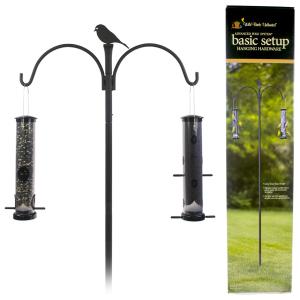How do I stop Raccoons?
Have you ever stepped outside in the morning and found your bird feeder laying on the ground, perhaps with a squirrel sitting there eating the spilled seed? Or maybe the feeder is still hanging, but the lid is broken or the perches are missing? Well, rarely is that squirrel to blame for this sort of mischief. Squirrels may chew on feeders (characterized by the dual lines left behind from the two front teeth gnawing), but rarely do they have the strength or dexterity required to actually lift large feeders or to pull them apart. Rather, this is more likely the work of the overnight shift, the Raccoons (Procyon lotor).
You have to admire the abilities of Raccoons sometimes. They have adapted incredibly well to our lifestyles, will eat just about anything that is edible and have incredible adaptations. Raccoons are incredibly intelligent, are adapted for the day or night (but are primarily nocturnal), can climb exceptionally well and have incredibly dexterous and sensitive hands and fingers. They are designed to be a problem for just about any bird feeder out there.
Many people don’t think or realize Raccoons are in their yards until the feeders end up damaged and on the ground. Damage can occur any time of year, but peaks in late spring as this is the time of year when raccoon assaults on feeders become more frequent and severe. This is largely due to the fact that most female raccoons will have babies who are getting bigger by the day and require more milk from mama. She must eat a lot more to keep up and your feeder is a pretty nice buffet for her. Most raccoons have a sweet tooth, so even fruit, jelly, or nectar feeders are at risk. Soon enough those babies will leave the den and will follow their moms to the feeders.

To Save your Feeders and Economize your Birdseed Budget, you Have Only 1 Option:
 Use properly sized, metal Raccoon Baffles on tall poles: Raccoons cannot jump onto a pole rather they can stretch out and grab onto a pole if it’s close enough to a tree, fence, deck etc. So placing a pole 4’ from anything sturdy enough to support a Raccoon is fine. If you want to prevent Raccoons and squirrels the top of a pole baffle should be 5' above the ground to prevent jump-overs by squirrels, and the pole itself must be 11' from anything sturdy enough (tree, fence, house, etc.) from which a squirrel could leap and gain access. The pole must also be tall enough so that all feeders stay above the top of the baffle. Most standard shepherd's crooks are not tall enough to achieve both of these rules. WBU's Advanced Pole System is and is an effective way to keep them away from feeders. Only Raccoon baffles will prevent Raccoons from climbing up a pole or 4 x 4 posts. You will find baffles quickly pay for themselves in seed saved.
Use properly sized, metal Raccoon Baffles on tall poles: Raccoons cannot jump onto a pole rather they can stretch out and grab onto a pole if it’s close enough to a tree, fence, deck etc. So placing a pole 4’ from anything sturdy enough to support a Raccoon is fine. If you want to prevent Raccoons and squirrels the top of a pole baffle should be 5' above the ground to prevent jump-overs by squirrels, and the pole itself must be 11' from anything sturdy enough (tree, fence, house, etc.) from which a squirrel could leap and gain access. The pole must also be tall enough so that all feeders stay above the top of the baffle. Most standard shepherd's crooks are not tall enough to achieve both of these rules. WBU's Advanced Pole System is and is an effective way to keep them away from feeders. Only Raccoon baffles will prevent Raccoons from climbing up a pole or 4 x 4 posts. You will find baffles quickly pay for themselves in seed saved.
Our patented Advanced Pole System® (APS) is a revolutionary concept and the foundation for successfully attracting birds to your backyard. Comprised of interchangeable hardware pieces, the APS lets you select the setup that best suits the habitat in your own backyard and the birds you want to attract.
1. Bring Feeders in Each Night: Since raccoons are primarily nocturnal, locking feeders in a secure garage or shed before it gets dark each night will deny them access. Of course, this is a bit tedious or may not fit your schedule, so may not work for everyone.
2. Locking 'em Down and Ration Food: WBU stocks several devices to help keep feeders from being knocked to the ground. Solution Clips fit over the end of shepherds hooks to stop raccoons from lifting feeders off the hook. Utility Chains easy-to-use devices to keep feeders hanging from tree limbs. We also have many feeders (suet, corn, fruit, etc.) which can be securely screwed to a tree or fence.
Once your feeders are secure, pay close attention to how much seed or suet your birds actually eat each day, then begin rationing out just enough food each morning so the feeders will all be empty before dark. If there is no food to be had at dusk, the raccoons usually lose interest.
Hot Pepper Options
In certain circumstances, where other methods aren't effective, WBU Hot Pepper Products may be the best option for deterring squirrels and other mammals. When feeders and food are placed in certain trees, on decks, or near windowsills, it may be difficult to keep away mammals including squirrels, raccoons, deer and rodents. In these situations, seed, suets, No-Melt Dough, Bark Butter, cylinders or Stackables™ with hot pepper may be a good solution. Only use products where the hot pepper is bound tightly in the product, such as our WBU Hot Pepper Products.
Approximately 90% of Eastern Gray Squirrels and Red Squirrels do not eat WBU Hot Pepper Products. There is also evidence to suggest that WBU Hot Pepper Products are effective at deterring a variety of mammals including but not limited to: Fox Squirrels, Eastern Gray Squirrels, Red Squirrels, rabbits, rats, mice, White-tailed Deer, Mule Deer, raccoons, opossums and skunks. There is also strong evidence to suggest they are also effective against bears, however if you live in bear country please read our section on Problem Solving Bears. WBU Hot Pepper Products may not be as effective when it comes to Eastern Chipmunks as they have fur-lined cheek pouches and this fur seems to act as a barrier to the effectiveness of the products.
Helpful Tips for Feeding WBU Hot Pepper Products
For all the information on Feeding WBU Hot Pepper Products please visit our Problem Solving with Hot Pepper page. Our Problem Solving with Hot Pepper page details everything you need to know about WBU Hot Pepper Products, including frequently asked questions (FAQ) such as, does it work to discourage squirrels, is it safe for birds to eat hot pepper, and is it safe for hobbyists to offer hot pepper foods. Here are a few helpful tips:
How to Feed WBU Hot Pepper Products?
When offering WBU Hot Pepper Products they must be the only thing in a feeder. In other words, you can’t mix WBU Hot Pepper Products with other non-hot pepper options. For example, you wouldn’t want to mix regular Bark Butter with Hot Pepper Bark Butter as animals will just eat around the spicy option. WBU Hot Pepper Products must be fed on their own to be effective.
Hot Pepper Safety
As pointed out by Jim Carpenter in The Joy of Bird Feeding, capsaicin coated seeds can bother people when it comes into contact with our eyes, nose, mouth and lips. It’s important to take care when using our WBU Hot Pepper Products. Rubber dish gloves would be a good accessory to have on hand when using these foods or washing feeders.
Can’t I just Make My Own Hot Pepper Products?
Items with hot pepper (capsaicin) cause a reaction in humans. If eyes, noses or lips are rubbed, then a reaction to hot pepper could range from mild to severe. Choosing products where the hot pepper is bound to the products (such as our WBU Hot Pepper Products), and taking caution when filling or washing feeders, is an important part of using these products safely. Do not attempt to make hot pepper products at home. Our WBU Hot Pepper Products have been specially formulated and tested to ensure they are safe for the birds. They are made in a facility where staff wear the proper safety equipment to ensure they don’t experience a reaction to the capsaicin. If you try making hot pepper deterrents at home it may not be safe for the birds or you!



